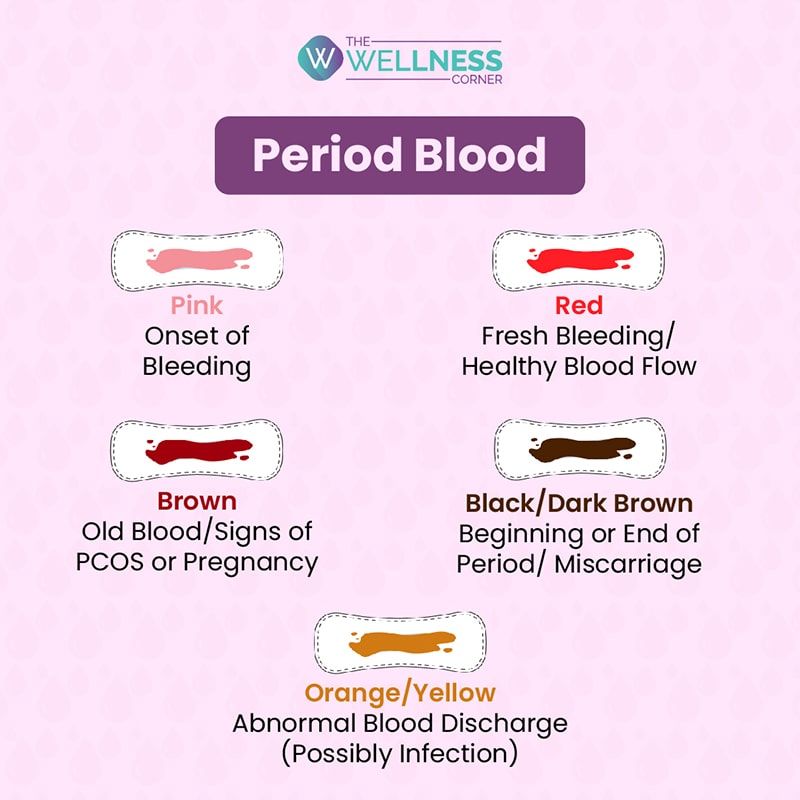What Does The Menstrual Blood Color Say About Your Health?
36 months ago
5 minute read.

The menstrual cycle is the shedding of the inner uterine lining through the vagina. Depending on several factors, the color of discharged blood may vary. And it's normal to get worried about the color variation and consistency of the blood unless you know the right reason.
However, menstrual blood says a lot about your health. From light pinkish-red to blackish-red, it can vary depending on the amount of oxygen reacted with blood. This article discusses why and when menstrual blood color varies. Also, whether or not it's normal to have menstrual color variation.
What is the Normal Blood Colour?
Normally, when you look at your veins, you see blue-colored blood. This doesn't mean your blood is blue. Also, if you are wondering why it comes out red, in case you cut your finger, then here's what you need to know.
Your blood has a pigment called Hb, i.e., hemoglobin. And in the center of its heme unit, there's Fe (iron). This Fe undergoes an oxygenation reaction, which makes blood appear red. Simply put, your blood turns red when it gets in contact with oxygen.
Veins carry deoxygenated blood with high CO2 and O2 content. Due to this, the blood appears blue and not red under a particular light's wavelength.
Why Does Menstrual Blood Color Varies?
The color of blood varies with the days of the menstrual cycle. The cycle usually comprises 3-5 days, with the first two to three days of heavy bleeding. Menstruation doesn't only involve the loss of blood, but the discharge is a mixture of blood, endometrium tissue, and mucous.
During a woman's first menstruation, the blood isn't purely red or dark red. It's usually pink. However, in your normal period cycle, the color of your menstrual blood is different. The volume of menstrual blood lost during each cycle ranges between 30-50ml. In case there are abnormal periods of bleeding, the color and the volume of blood would vary. According to Research Trusted Source, losing 20% of one's blood can be life-threatening.
Different Period Blood Colors And What They Mean?
Menstrual blood shows different colors during the menstrual cycle, which are as follows:

1. Pink
During the initial discharge, the blood mixes with the vaginal mucus and appears pink. The pink period blood is also there in the case of first menstruation, referred to as menarche.
2. Red
On your second or third day, it usually turns red or bright red. The longer the blood stays in the uterus, the darker it becomes.
3. Dark-brown
Clearly, the amount of O2 that reacts with the blood determines the intensity of the color. However, brown blood discharge could be a sign of pregnancy, termed implantation bleeding.
4. Black
Sometimes, you see heavy blood clots resulting from the thickening of the endometrium. These clots generally vary from reddish-black to brownish-black.
5. Orange, Yellow (in case of infection)
In case you have orange, yellow, or any other abnormal blood discharge, you may need to see a doctor. Orange or yellow color is merely a sign of infection.
No matter what blood color you see during your menstrual cycle, there's nothing to fear about under normal conditions. But every time, this is not, of course, the case. If your experience abnormal intensity or consistency of period blood, it could be something to be worried about.
Pro Tip: You can get the information through a period blood chart that tells you about the different colors of period blood.
Also Check → Big Confusion: Can Women Swim During Periods?
Abnormal Menstruation
A woman's period can be a source of great discomfort and occasionally signal a serious health problem. If your discharge smells foul or you are facing difficulty in urinating, it's not normal. Also, uterus inflammation, itching, weight loss, appetite loss, and exceptionally heaving bleeding aren't good signs either.

In case you experience the above symptoms, you could be suffering from anemia, sexually transmitted diseases (STDs), pelvic inflammatory disease, uterine cancer, bleeding disorder, etc. Don't feel embarrassed or shy if you are suffering from such problems. Try to seek medical assistance right away.
Tips For A Healthy Reproductive System: Dietary Changes
Diet and exercise play a significant role in maintaining good menstrual health. The food you take in directly impacts your fertility. Basically, irregular menstruation is nothing but majorly a lifestyle disorder. And the color of menstrual blood somehow indicates the health of your reproductive system.
Usually, obese women are at higher risk of suffering from PCOD. Therefore, it's important to keep healthy eating habits along with daily workouts. Other than this, stress can also hamper your normal hormonal cycle. If you stay under consistent work pressure, you are likely to miss your periods.
Also Check → Is It Safe To Have Sex During Periods?
Foods To Boost Menstrual Health And Blood Circulation
Simply changing your eating habits can solve half of your lifestyle issues. Your food choices have a lot to do with your reproductive health. The following foods have been found to improve the health of your reproductive system:
- Walnuts
- Eggs
- Banana
- Berries
- Beans
- Whole grains
- Salman
These food items add the required nutrients to your body while regulating your menstrual cycle. Also, blood circulation does have a role to play. Blood flow during menstruation could be boosted by consuming some specific foods. The common foods that can contribute to increasing your body's blood circulation are jaggery, beetroot, spinach, papaya, chocolates, and pineapple. If you are allergic to any of the foods mentioned, try consulting a specialist before you come to any decision.
Also Check → No Menstruation Or Absence Of Periods In A Woman? Is That Even Possible?
Final Word
The color of your menstrual blood is directly linked to the overall health of your reproductive system. However, menstrual blood color ranging from pink to dark brown isn't concerning.
However, if you notice something else and in case you are missing your periods or experiencing unusual bleeding, cramps, or infection, you should consult a doctor. Abnormal menstruation interferes with daily activities, causing a great deal of pain. Nevertheless, hygiene, a healthy diet, and exercise are three simple keys to a thriving reproductive system. If you have a problem that isn't listed here, see a gynecologist for an accurate diagnosis.

Leave a Comment
Related Articles
Health Checks @ Home
Service
Explore
© 2026 Truworth Health Technologies Pvt. Ltd.




